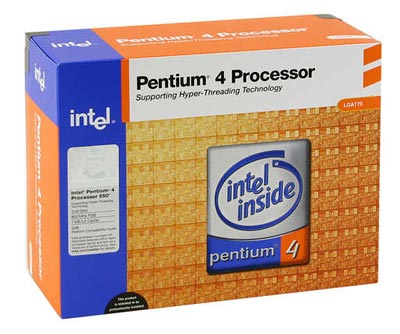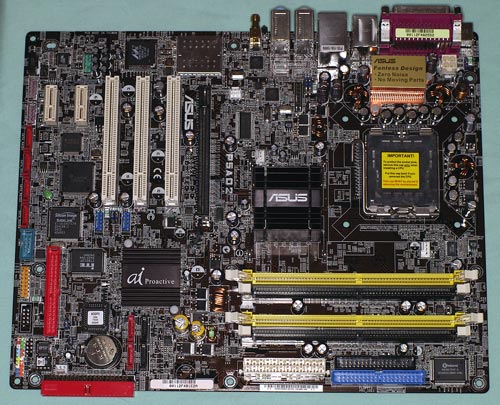High End Buyer's Guide - September 2004
by Wesley Fink on August 30, 2004 12:22 AM EST- Posted in
- Guides
CPU and Motherboard Alternatives
CPU: Intel Pentium 4 560 (3.6Ghz)Motherboard: Asus P5AD2 Premium (Intel 925X)
Price: CPU - $505 shipped (Retail with HSF). Motherboard - $264 shipped
It was difficult to decide between the Single-Channel Socket 754 Athlon 64 and the new Intel Socket 775 for the High-End alternative. Despite the massive increase in memory bandwidth that comes with the Dual-Channel 939, the fact remains that the Athlon 64 is not particularly bandwidth-starved compared to recent deep-pipe Intel designs. As you can see in the launch article on Socket 939, this translates into performance of the single-channel 754 Athlon 64 that is only 2% to 9% slower than the new 939 at the same speed. In real terms, this means that a Socket 754 combined with a second-generation Socket 754 motherboard with AGP/PCI locks is still slightly outperforming Intel's latest and greatest Pentium 4 560 (3.6GHz). The new pricing of the 2.4GHz 3700+ at about $525 also makes this tempting for the High-End Value shopper. The 754 is still a very good alternative, but in the end, the new Socket 775 on one of the motherboards that solves the Intel OC lock riddle won out as the High-End alternative due to the combination of features and future.

Intel produces processors with locked multipliers, so for raw performance, we chose the highest Intel stock speed. The Intel 560, running at 3.6GHz and based on the 90nm Prescott core, is the fastest Intel CPU you can buy today. As Anand found in the Socket 775 launch review CPU benchmarks, the 560 is generally faster than the more expensive 3.4EE, which has double the cache, but is based on the 130nm Northwood core. Most Socket 775 processors that we have tested tend to top out in the 3.8GHz to 4.0GHz range with modest voltage increases, so overclockers choosing a 775 CPU may want to choose a slower 775, like the 3.2GHz to balance ultimate overclock with board Clock frequency capabilities.
In this case, the Asus P5AD2 tops out at 278 with ATI PCIe video or about 260 with nVidia PCIe. We also showed, in our DDR2 memory roundup, that all current DDR2 memory could run at DDR2 667, which is achieved at a Clock frequency of 250. This means that if you are an experienced overclocker, you can achieve the same or higher performance with a 3.2E Socket 775 matched to the Asus P5AD2.
However, this is the High-End Buyer's Guide and there is no doubt that overall, the 560 is the fastest stock Intel Socket T processor that you can buy. This makes the 560 the ideal choice for a Socket T, PCI Express, DDR2 High-End system.

The Intel 925X chipset is Intel's Enthusiast chipset, and we recently compared 925X motherboards in our 925X Roundup. The Gold Editor's Choice in that roundup was the Asus P5AD2, which makes the Asus the logical choice for our High-End Intel system.
The P5AD2 Premium is clearly top-of-the-line in every way. All of the Asus Proactive AI (Artificial Intelligence) features are included, and Asus proudly advertises the overclocking features of the P5AD2 Premium. This includes a special cooling plate on the bottom of the board in the CPU area that Asus calls Stack Cool.
Asus includes Dual Gigabit PCI Express LAN on the P5AD2, with both LAN ports powered by the new Marvel 88E8053 Ethernet controllers. You will also find a complete WiFi set-up with an 802.11g card and antenna included for the WiFi slot. Asus uses the premium C-Media CMI9880 codec supporting the Intel High-Definition audio, with 8 channels and Dolby Digital Live technology support. The P5AD2 also adds the DDR2 memory option of 600MHz at stock speed in addition to the common 533 and 400 options.
The storage area is one area where the Asus stands out compared to other 925X boards. All 925X support the ICH6R standard 4 SATA/1 IDE (2drives) configuration. The Asus adds 4 more SATA ports for a total of 8 SATA ports, and also adds an ITE controller for 2 more IDE devices for a total of 4.
When Socket 775 was launched, it did not appear that any of the new 925X/915 motherboards would ever become a recommended performance motherboard. Performance was fine if you looked only at stock speeds, but the 925x/915 boards appeared limited to about a 10% overclock by design. This severely limited performance at the very top compared to Intel 875/865 chipset boards. However, the P5AD2 has turned out to be the best overclocker that we have seen so far among the 925X motherboards. In our tests, the Asus reached 278 FSB with the difficult combination of a top-end ATI X800 XT PCIe video card and a SATA hard drive. This puts the P5AD2 in the same performance ballpark as the best 875 boards, making it easier to choose a 925X system as the high end alternative system.
The P5AD2 is an expensive motherboard, but it will take 775 performance to places that are difficult to reach with other 925X motherboards. It was designed from the start to be a dream board for Performance computing, and Asus even provides a full range of AI overclock options for the more timid, with auto presets from 5% to 30% overclock, which represent a range of auto overclocks to FSB1066/DDR2-710.
There is also a full range of both familiar and new manual settings for overclockers who like to dial their own.
Listed below is part of our RealTime pricing engine, which lists the lowest prices available on the Intel CPUs and motherboards from many different reputable vendors:
If you cannot find the lowest prices on the products that we've recommended on this page, it's because we don't list some of them in our RealTime pricing engine. Until we do, we suggest that you do an independent search online at the various vendors' web sites. Just pick and choose where you want to buy your products by looking for a vendor located under the "Vendor" heading.










53 Comments
View All Comments
mcveigh - Monday, August 30, 2004 - link
what about for a storage drive the new maxtors with 16mb cache and TCQ features?didn't Anand hint a little while ago there would be a review of them ?
of course now he has a wife to keep happy....there goes the place! ;)
Booty - Monday, August 30, 2004 - link
Just agreeing about the price engine thing - scrolling that far is pretty annoying. If they have to have it that way to earn money and keep the site free, so be it... but if not, I know I'd definitely appreciate it being moved.PrinceGaz - Monday, August 30, 2004 - link
Good article, I couldn't really fault any of the suggestions this time :) The only things that might be worth considering as this is a high end system is spending an extra $200-300 and throwing in 2GB of memory, either as 2x1GB sticks if they are just as fast, else as 4x512MB. As I do a bit video capturing and editing, and like many broadband users fill a lot of space quickly (don't ask), I'd definitely go for the Maxtor 300MB drive with 16MB cache for $260. Both of those are only minor points though and overall I agree with the suggestions.One thing I've been thinking about for a few days now are dual Opteron systems. A couple of Opteron 250's on a suitable dual S940 mobo would only cost about $1000 more than the FX53 system and mobo. Alternatively a couple of 248's will lower the differential to around $600.
The important thing is that multi-threaded apps are becoming increasingly common because of HT, and next year when dual core CPUs start appearing it'll be normal for any CPU heavy application to be multi-threaded so as to take full advantage of them. I know you could always replace the FX53 with a dual-core Toledo next year, but why wait for the extra performance when you can get it today with a couple of 250's (and the 250's could be replaced with dual-core Italy's next year giving even more power if desired).
The extra thousand dollars is a roughly 30% total price increase and is not insignificant, but you'll get considerably more than 30% performance improvement with any multi-threaded CPU heavy application, so its money well spent. In fact its hard not to recommend it as the high end choice as its still comes in under the $5000 limit.
iversonyin - Monday, August 30, 2004 - link
i would rather have dual dell 2001 then 23" apple23" apple is nice but also come with a steep price.
dont we all love dual-monitor here?
but if anyone can spend $3600 on a computer, what extras $2000 to them
Wesley Fink - Monday, August 30, 2004 - link
#3 - Typo corrected.I agree the Apple is a nice display, but Apple uses a proprietary Digital interface called ADC instead of the standard DVI Connector. Some enterprising manufacturers have developed some conversion connectors but the converter doesn't work with most nVidia video cards. In the end this is not a solution we could recommend right now.
There is also the cost difference, since the 20.1" Dell is about $800 and the 23" Apple is about $2000. A 260% price increase to go from a great 20.1" display to an Apple 23" display and converter seemed a bit much. There is also a 30" Apple Cinema display BTW.
Fr0zeN2 - Monday, August 30, 2004 - link
Great guide, but...Yeah, the pricing engine's been bugging me for a while now too. Honestly, there are sites like pricewatch.com that you can go to to view prices on these, as well as many other similar products. Especially when your listings include products that have absolutely no relevance to the one mentioned (helooo gf5950 prices?).
kherman - Monday, August 30, 2004 - link
#5This is a free site. If you like it that way, I'd get used to those advertisements.
-----------
Aside from that, 74 gig? If I made a "dream rig" yuo'd be seeing 400 GB+ in RAID 5 (3x200)
kherman - Monday, August 30, 2004 - link
Of course, for this rig, get the BFG 6800 UltraJonathanYoung - Monday, August 30, 2004 - link
I just want to add a comment I've been wanting to make for awhile now... would you please add a link to the next page *above* the realtime pricing engine so that people who do not wish to view the pricing engine don't have to scroll alllllllll the way down just to get to the next page? This was especially bad on the "AGP Video" section of this guide. Thank you!shuttleboi - Monday, August 30, 2004 - link
Why hasn't Anandtech reviewed any 6800GT videocards???